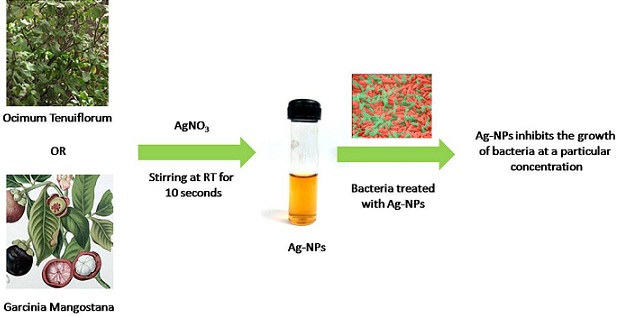
Open Access

Subscription Access
Comparative study of antibacterial activity of standard antibiotic with silver nanoparticles synthesized using ocimum tenuiflorum and garcinia mangostana leaves
Nikesh Gupta, Chetna Gupta, Sandeep Sharma, Rakesh Kumar Sharma, H. B. Bohidar
Abstract
This study investigates an efficient and sustainable route of Ag-NPs preparation using leaf extracts of two plants, Ocimum tenuiflorum (tulsi) and Garcinia mangostana (mangosteen), well adorned for their wide availability and medicinal property. Silver nanoparticles (Ag-NPs) have been synthesized at room temperature following a green approach by reducing the corresponding salt (AgNO3) with plant leave extract. The reaction was instantaneous and the average diameter of the particles formed was around 15nm and 20nm (for ocimum tenuiflorum) and 25nm and 38nm (for garcinia mangostana) as measured by HRTEM and DLS techniques respectively. Electron diffraction pattern showed that the particles were crystalline in nature. These particles were highly stable for more than four months at room temperature in both the cases. These nanoparticles were used for assessing antibacterial activity studies against both gram positive (Staphylococcus aureus) and gram negative (Escherichia coli) bacteria. The minimum inhibitory concentration (MIC) of silver nanoparticles synthesized using Ocimum Tenuiflorum against these two pathogens was found to be 0.25µg/mL (E. coli) and 0.64µg/mL (S. aureus) while for Garcinia mangostana it was 0.38 µg/mL (E. coli) and 0.92 µg/mL (S. aureus). The inhibition zone diameter (IZD) in case of Ocimum tenuiflorum was 30mm (with both E. coli and S. aureus) while with garcinia mangostana it was 25mm (E. coli) and 28mm (S. aureus).
Keywords
Green approach; silver nanoparticles; room temperature; antibacterial activity; plant extract
Full Text:
PDF

ISSN 2347–9825
Authors/visitors are advised to use Firefox browser for better experience of journal site.
Open Access: Researcher from developing/low economy countries can access the jorunal contents through WHO-HINARI .

 ISSN 2347-9825
ISSN 2347-9825

